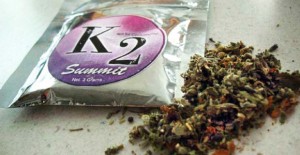Gray, Eliza. “The Drug Threat in Plain Sight.” Ebscohost.com. Time. 21 Apr. 2014. Web. 19 Jul. 2015.
 Eliza Gray, a Time Magazine reporter, investigates the substitute for pot which is synthetic marijuana. Gray covers the the creation of the the designer drug, the various reason for it’s use and the harmful effects it has on people. More importantly, she highlights the law’s losing battle with keeping the drug of the street.
Eliza Gray, a Time Magazine reporter, investigates the substitute for pot which is synthetic marijuana. Gray covers the the creation of the the designer drug, the various reason for it’s use and the harmful effects it has on people. More importantly, she highlights the law’s losing battle with keeping the drug of the street.
A claim made by Gray, synthetic marijuana is a becoming the most complicated drug problem beating out others such a cocaine and heroin. Gray attributes this to the drug being able to be sold in public because variants aren’t illegal although they attempt to mimic the “high” of cocaine and marijuana. To properly illustrate the harmful effects of synthetic marijuana Gray tells the story of Jesse, an 18 year old, that was smoking on the various names of synthetic marijuana, K2. According to the story Jesse’s mom notice there was something weird about her son but disregarded it when he told her it was “like legal marijuana.” Gray’s point here is that many young people think that it is a form of legal marijuana but don’t know all the chemicals that are sprayed into it. Along with this Gray marks the fact that these things along with the cheap price and not showing up on a drug test as the reason teens buy synthetic marijuana. Inversely, Gray remarks that while people argue about the status of marijuana as a gateway drug that it is relatively safe and a reason that the Colorado and Washington movements were successful. The author brings this up in order to emphasize the harmful effects such as vomiting, nausea and excessive heart rate.
 Gray also gives insight into how law enforcement struggles to keep the harmful substance off the streets, such as outlawing things that replicate the effects of marijuana and the many things that sellers do to keep it “legal.” What Gray is saying that while the government is making the chemicals that comprise the drug illegal the chemist tweak it so it can purport to be “legal.” Furthermore, Gray points out that most of the people buying synthetic marijuana, under names such as K2, Spice or anything else, are young teens that could not buy cigarettes or alcohol. Gray makes light of how even if marijuana is made legal it still wouldn’t be accessible to teens so they resort to the designer drug. Gray also noted that many people aren’t aware of the difference between pot and synthetic pot. Grey affirms this by saying that a man in Colorado, where weed is legal, bought some synthetic brand that had the same name as real brand. Gray remarks that dealers are using the rise of legal, natural marijuana in order to push their deadlier version.
Gray also gives insight into how law enforcement struggles to keep the harmful substance off the streets, such as outlawing things that replicate the effects of marijuana and the many things that sellers do to keep it “legal.” What Gray is saying that while the government is making the chemicals that comprise the drug illegal the chemist tweak it so it can purport to be “legal.” Furthermore, Gray points out that most of the people buying synthetic marijuana, under names such as K2, Spice or anything else, are young teens that could not buy cigarettes or alcohol. Gray makes light of how even if marijuana is made legal it still wouldn’t be accessible to teens so they resort to the designer drug. Gray also noted that many people aren’t aware of the difference between pot and synthetic pot. Grey affirms this by saying that a man in Colorado, where weed is legal, bought some synthetic brand that had the same name as real brand. Gray remarks that dealers are using the rise of legal, natural marijuana in order to push their deadlier version.
This article is helpful to me because I am going to write about the how synthetic and legal marijuana interact. In the article Gray writes about the harmful side of synthetic marijuana and how it’s troublesome. This article would not only be help to my peers seeking to write about synthetic marijuana but also to those looking to write about how other drugs effect and are effected by the legalization of marijuana.

I find it very surprising to think that this form of “legal” synthetic marijuana does not show up in drug tests. The fact that it imitates the “high” one would get off of cocaine or marijuana is enough to imagine just how many toxic chemicals are being used to create this drug.
This article caught my attention because it discusses synthetic marijuana. A drug that I have heard of but know nothing about it. I believe this debate would be more intriguing if the author contended that the legalization of marijuana actually increased the sells of synthetic marijuana because the designed drug was less expensive to purchase.